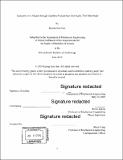Transport of n-alkanes through graphene nanoporous atomically thin membrane
Author(s)
Han, Kyung-Eun.
Download1130589055-MIT.pdf (13.96Mb)
Other Contributors
Massachusetts Institute of Technology. Department of Mechanical Engineering.
Advisor
Rohit Karnik.
Terms of use
Metadata
Show full item recordAbstract
Accurately characterizing molecular transport through a nanoporous atomically thin graphene membrane is important in determining potential for graphene's application as a filter. Amongst many factors that affect the transport, the effect of size of molecules is analyzed in this paper. Diffusion of n-alkanes between C10 and C18 was analyzed to isolate the effect of molecule size in transport trends. The n-alkanes are chosen as the solutes for their similar long-chains but differing lengths. Differently branched structures cause variable interactions with graphene between molecules. Thus, this structural consistency in n-alkanes make them optimal solutes. Additionally, these molecules are comprised of only carbon and hydrogen, allowing the same functional groups and polarities. However, their distinct boiling points allow detection in the gas chromatography-mass spectrometry (GCMS). A diffusion cell with feed and permeate chambers, separated by a semipermeable membrane, was used to induce diffusion with difference in solute concentration between the chambers. Diffusion concentration and rates were calculated using GCMS analysis of samples taken over 6-hour period during the diffusion. The calculations were done for diffusion with and without graphene membrane for comparison. When integrating the GCMS peaks, two types of integration methods - wide-peak and narrow-peak integrations - were used to estimate the error due to difficulties in identifying peak boundaries. These results were further compared to the inherent diffusivity coefficients of the molecules, in order to quantify the selectivity imparted by graphene for diffusion. The diffusion trends from each data set were compared to the diffusion trend from inherent diffusivity coefficients, which shows that diffusiyity should decrease with larger and heavier n-alkanes. The experimentally obtained data shows that smaller molecules diffused at faster rates, and there was a noticeable drop in the diffusion transport between C 12 and C 14. This is consistent with the expected trend. Studies that minimize sources of errors are recommended to further understand the transport of alkanes through graphene.
Description
Thesis: S.B., Massachusetts Institute of Technology, Department of Mechanical Engineering, 2019 Cataloged from PDF version of thesis. Includes bibliographical references (pages 67-68).
Date issued
2019Department
Massachusetts Institute of Technology. Department of Mechanical EngineeringPublisher
Massachusetts Institute of Technology
Keywords
Mechanical Engineering.